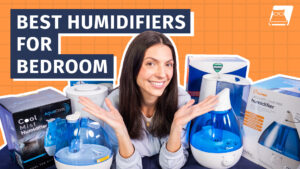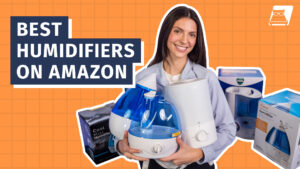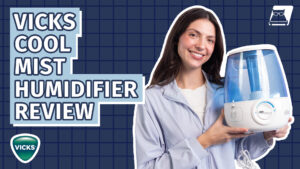How Do Humidifiers Work?
Disclosure: By clicking on the product links in this article, Mattress Nerd may receive a commission fee at no cost to you, the reader. Read full disclosure statement.
Humidifiers may be a go-to parenting trick when children are sick, but they could help improve sleep quality regardless of age or illness. These little machines add moisture to your sleeping environment to help maintain an appropriate humidity level. Here’s how humidifiers work, and more importantly, how they can help you enjoy a good night’s sleep.
Types of Humidifiers
While all humidifiers are designed to boost the relative humidity level in the surrounding environment by pushing out water vapor mist, there are different versions that work in different ways. Here are some of the most common humidifiers on the market.
Cool Mist
As the name implies, a cool mist humidifier is designed to push cool moisture into the air. It doesn’t involve hot water or steam, so this is the best choice for households with children, infants, or curious pets.
Warm Mist
This type of humidifier is similar to the cool mist version, but it produces steam instead of cool moisture. However, because they involve boiling water and steam to boost the humidity in a room, these are best used in homes with adults only.
Ultrasonic
Ultrasonic diffusers use a vibrating device known as a nebulizer to create a fine mist. Technically, they fall into the cool mist category. These tend to be a quiet option and they don’t involve steam, so they work well for just about anyone.
How do Humidifiers Work?
The components and mechanisms of a humidifier vary from one type to the next. While the end result is the same, they all work a little bit differently.
Cool mist
Cool mist humidifiers can work in a few ways. Some use a fan to blow air through a wet filter, which releases water droplets into the air. The most common type of cool-mist humidifier uses ultrasonic vibrations to propel a fine mist into the surrounding air. A third type uses a rotating disc and a diffuser to create tiny water droplets that permeate the air.
Regardless of the mechanism used, cool-mist humidifiers increase relative humidity levels by adding cool moisture to the surrounding environment.
Warm Mist
Warm mist humidifiers are a similar idea – they add moisture to a room to boost humidity. But instead of creating a cool mist with lukewarm water, warm mist humidifiers actually boil the water to convert it from a liquid into a gas. They work quickly and quietly to increase humidity levels and can warm up a room too. And because the water is boiled, the resulting vapor is purified.
Ultrasonic
This type of cool-mist humidifier uses a nebulizer or high-frequency sound vibration to break apart the water into small droplets, creating a fine mist. Then, a fan pushes the mist into the air. This process tends to be quieter than some other cool mist humidifier mechanisms.
Benefits of Sleeping with A Humidifier
By adding moisture to your bedroom, a humidifier can make for a more comfortable sleep experience.
- Hydrated skin and airways. Humidifiers resolve many of the issues caused by dry indoor air – think dry sinuses, cough, bloody noses, cracked lips, or dryness in the mucous membranes – that could be making it hard to sleep well.
- Relief from allergies, asthma, or infections. Dry air can aggravate symptoms of these conditions. Cool mist humidifiers specifically may also help ease the coughing and congestion associated with the common cold. The American Academy of Pediatrics recommends using cool mist humidifiers for children with colds or the flu, but advises against warm mist models.
- Reduced snoring. Mucus from nasal congestion can cause snoring by blocking airways. Since humidifiers can help reduce congestion, they may also reduce snoring.
How to Choose the Right Humidifier for You
With so many options, how can you decide which humidifier is best for you? Here’s what to keep in mind as you shop.
- Prioritize your sleep environment. Keep in mind that the elements of some humidifiers can be noisy. A warm mist or ultrasonic humidifier is probably your best option if you’re a light sleeper. Still, make a point of scanning reviews before you buy to see if customers describe a particular model as quiet or noisy.
- Think safety first. If your household has small children or inquisitive pets, opt for a cool-mist humidifier to avoid burning or scalding accidents.
- Consider size and style. Humidifiers have varying outputs, so look for a model that’s designed for your room’s size. Remember to factor in the size of the humidifier itself as well – it needs to sit on a flat, level surface in your bedroom. And because it won’t be hidden, you may also want to opt for a style that suits your decor.
- Be clear about maintenance needs. Some humidifiers have filters that will require replacing at some point, so keep this ongoing and additional cost in mind. And regardless of which model you buy, every humidifier will need to be cleaned at some point. If you’re looking for convenience, look for models with pieces that can go in the dishwasher.
- Convenience factor. Check for details like run time and basic operation to ensure you’re getting a model that you’ll feel comfortable using.
Takeaway
Humidifiers add moisture to the air, which can improve sleep comfort and quality. Choosing between cool mist, warm mist, or ultrasonic diffusers is largely a matter of considering your preferences and factoring in safety. No matter which model you get, remember to follow the directions carefully to ensure you’re using your humidifier appropriately.
Source List
Baughn, Julie. (2021). Warm-mist versus cool-mist humidifier: Which is better for a cold? https://www.mayoclinic.org/diseases-conditions/common-cold/expert-answers/cool-mist-humidifiers/faq-20058199
Caring for your child’s cold or flu. (2022). https://healthychildren.org/English/health-issues/conditions/flu/Pages/caring-for-Your-childs-cold-or-flu.aspx
Humidifiers: Ease skin, breathing symptoms. (2021). https://www.mayoclinic.org/diseases-conditions/common-cold/in-depth/humidifiers/art-20048021?pg=1


